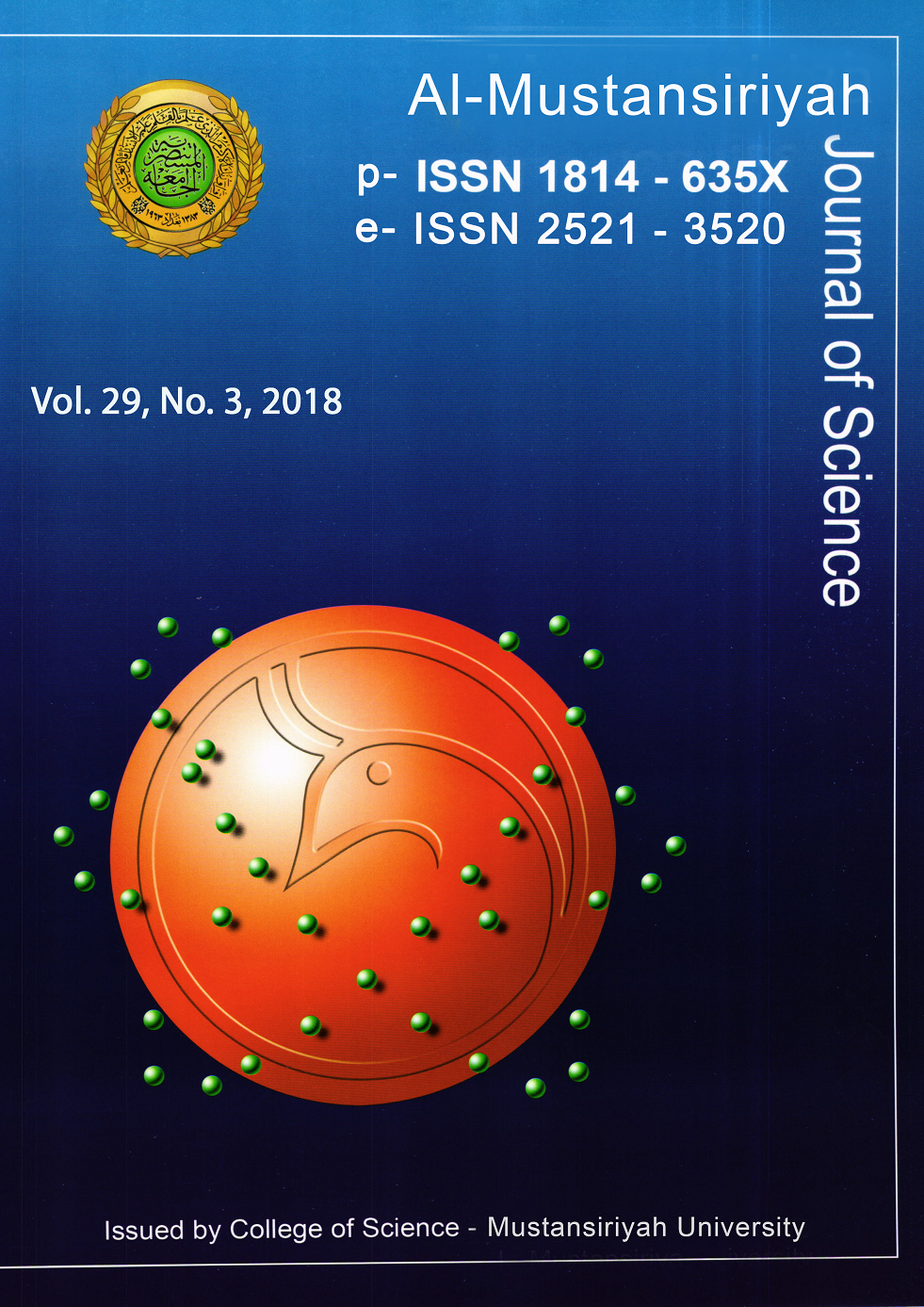Superhydrophobic Aerogel as Sorbents for Iraqi Crude Oil Leaked In Water
DOI:
https://doi.org/10.23851/mjs.v29i3.630Keywords:
Aerogel, superhydrophobic silica, crude oil, environmental pollution, oil absorbing.Abstract
A superhydrophobic aerogel has been utilized as adsorbed the Crude oil leaked during transport in the waters of the Tigris and Euphrates rivers, and determine the capacity absorbing of the aerogel powder for crude oil. This technique is very important to get rid of environmental pollution caused by the leakage of crude oil in water, which in turn cause the death of fish, this application is an important economic wealth in the country, preliminary tests on Tigris and Euphrates rivers mixed with the crude oil, by using the aerogel in powder form to clean the water from crude oil, the study depended on two parameters are surface area and contact angle. We found that the increasing on surface area lead to increasing on the capacity of adsorbing the crude oil from water, also this result with contact angle.Downloads
References
T.-T. Lim and X. Huang, "Evaluation of kapok (Ceiba pentandra (L.) Gaertn.) as a natural hollow hydrophobic–oleophilic fibrous sorbent for oil spill cleanup," Chemosphere, vol. 66, pp. 955-963, 2007.
M. B. Borup, Pollution Control for the Petrochemicals Industry: CRC Press, 2018.
Z. Chu, Y. Feng, and S. Seeger, "Oil/water separation with selective superantiwetting/superwetting surface materials," Angewandte Chemie International Edition, vol. 54, pp. 2328-2338, 2015.
M. S. Manga, T. N. Hunter, O. J. Cayre, D. W. York, M. D. Reichert, S. L. Anna, et al., "Measurements of Submicron Particle Adsorption and Particle Film Elasticity at Oil–Water Interfaces," Langmuir, vol. 32, pp. 4125-4133, 2016.
Z. Xu, Y. Zhao, H. Wang, H. Zhou, C. Qin, X. Wang, et al., "Fluorine-free superhydrophobic coatings with pH-induced wettability transition for controllable oil–water separation," ACS applied materials & interfaces, vol. 8, pp. 5661-5667, 2016.
H.-C. Yang, K.-J. Liao, H. Huang, Q.-Y. Wu, L.-S. Wan, and Z.-K. Xu, "Mussel-inspired modification of a polymer membrane for ultra-high water permeability and oil-in-water emulsion separation," Journal of Materials Chemistry A, vol. 2, pp. 10225-10230, 2014.
C. H. Lee, B. Tiwari, D. Zhang, and Y. K. Yap, "Water purification: oil–water separation by nanotechnology and environmental concerns," Environmental Science: Nano, vol. 4, pp. 514-525, 2017.
H. Lai, X. Yu, M. Liu, and Z. Cheng, "One-step solution immersion process for the fabrication of low adhesive underwater superoleophobic copper mesh film toward high-flux oil/water separation," Applied Surface Science, vol. 448, pp. 241-247, 2018.
W. A. Twej and I. F. Al-Sharuee, "Influence of reactant catalyst type and Drying Control Chemical Additives (DCCA) on optical and structural properties of silica aerogel prepared via ambient pressure drying," Iraqi Journal of Science, vol. 58, pp. 63-70, 2017.
I. F. Al-Sharueez and W. A. Twej, "Study the Effect of Doping with Chromium Chloride on Silica Aerogel Properties Prepared with Ambient Pressure," IOSR Journal of Applied Physics (IOSR-JAP), vol. 9, pp. 28-32, 2017.
J. G. Reynolds, P. R. Coronado, and L. W. Hrubesh, "Hydrophobic aerogels for oil-spill cleanup? Intrinsic absorbing properties," Energy Sources, vol. 23, pp. 831-843, 2001.
D. Wang, T. Silbaugh, R. Pfeffer, and Y. Lin, "Removal of emulsified oil from water by inverse fluidization of hydrophobic aerogels," Powder Technology, vol. 203, pp. 298-309, 2010.
M. Padaki, R. S. Murali, M. S. Abdullah, N. Misdan, A. Moslehyani, M. Kassim, et al., "Membrane technology enhancement in oil–water separation. A review," Desalination, vol. 357, pp. 197-207, 2015.
B. Wang, W. Liang, Z. Guo, and W. Liu, "Biomimetic super-lyophobic and super-lyophilic materials applied for oil/water separation: a new strategy beyond nature," Chemical Society Reviews, vol. 44, pp. 336-361, 2015.
J. Li, D. Li, Y. Yang, J. Li, F. Zha, and Z. Lei, "A prewetting induced underwater superoleophobic or underoil (super) hydrophobic waste potato residue-coated mesh for selective efficient oil/water separation," Green Chemistry, vol. 18, pp. 541-549, 2016.
M. Visanko, H. Liimatainen, J. A. Sirviö, J. P. Heiskanen, J. Niinimäki, and O. Hormi, "Amphiphilic cellulose nanocrystals from acid-free oxidative treatment: physicochemical characteristics and use as an oil–water stabilizer," Biomacromolecules, vol. 15, pp. 2769-2775, 2014.
Y. Si, Q. Fu, X. Wang, J. Zhu, J. Yu, G. Sun, et al., "Superelastic and superhydrophobic nanofiber-assembled cellular aerogels for effective separation of oil/water emulsions," ACS nano, vol. 9, pp. 3791-3799, 2015.
L. Hu, S. Gao, X. Ding, D. Wang, J. Jiang, J. Jin, et al., "Photothermal-responsive single-walled carbon nanotube-based ultrathin membranes for on/off switchable separation of oil-in-water nanoemulsions," ACS nano, vol. 9, pp. 4835-4842, 2015.
K. Fatima, A. Imran, I. Amin, Q. M. Khan, and M. Afzal, "Successful phytoremediation of crude-oil contaminated soil at an oil exploration and production company by plants-bacterial synergism," International journal of phytoremediation, vol. 20, pp. 675-681, 2018.
S. T. Nguyen, J. Feng, S. K. Ng, J. P. Wong, V. B. Tan, and H. M. Duong, "Advanced thermal insulation and absorption properties of recycled cellulose aerogels," Colloids and Surfaces A: Physicochemical and Engineering Aspects, vol. 445, pp. 128-134, 2014.
J. Feng, S. T. Nguyen, Z. Fan, and H. M. Duong, "Advanced fabrication and oil absorption properties of super-hydrophobic recycled cellulose aerogels," Chemical Engineering Journal, vol. 270, pp. 168-175, 2015.
A. V. Rao, N. D. Hegde, and H. Hirashima, "Absorption and desorption of organic liquids in elastic superhydrophobic silica aerogels," Journal of colloid and interface science, vol. 305, pp. 124-132, 2007.
Downloads
Key Dates
Published
Issue
Section
License
Copyright (c) 2019 Al-Mustansiriyah Journal of Science

This work is licensed under a Creative Commons Attribution 4.0 International License.
(Starting May 5, 2024) Authors retain copyright and grant the journal right of first publication with the work simultaneously licensed under a Creative Commons Attribution (CC-BY) 4.0 License that allows others to share the work with an acknowledgement of the work’s authorship and initial publication in this journal.






















